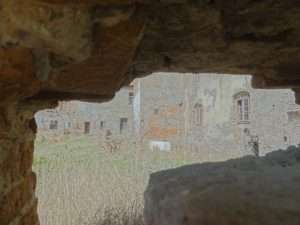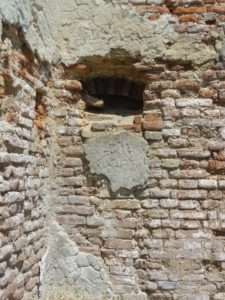Lakács
Lakács (Slovak: Lukáčovce) is a village in the Nyitra (Nitra) district of the Nyitra (Nitra) region, Slovakia. It is situated 18 km northwest of Nyitra (Nitra). Since it was located on the Borderland of the Kingdom of Hungary during the Ottoman Wars, the area suffered a lot from the fighting in the Érsekújvár (Nové Zámky) region.

To the northwest of the center of the village of Lakács (Lukáčovce) stands the Lakács Castle, a square-shaped castle of 50×50 m with slightly protruding towers at the corners. The mansion has a one-lane layout and is an exemplary example of smaller fortifications.

Today, the neglected walls of the imposing building are still 7-8 meters high. The castle is a two-story, four-winged building with towers at the corners. The ground floor of the southeastern farm building, built in 1571, has been destroyed. The facades are simple. The northeast wing is enriched with painted sgraffito.

According to research, the fortress on the side of the hill in the past was separated by a wide moat. Under the mansion, there are underground corridors leading out to several directions. However, these are largely overwhelmed.

The entrance rhizalite of the northeast wing, built after 1620, stands out. The keyhole loopholes in the parts of the defensive wall connecting the southern and western bastions, as well as in the western and northwestern walls, are intact. Underneath, there is also a series of rectangular loopholes. The building has hipped and half-hipped roofs, the bastions have mansard roofs. The rooms of the north wing have a box dome vault and the bastions have a ribbed cross vault.

One wing of an early Gothic building from the 15th century was saved, but the rest of the mansion is dilapidating. The decaying building is now uninhabited and not open to the public. Its roof structure has been restored.

The present settlement was first mentioned as an estate in 1264, but experts date its foundation between the 13th and 15th centuries. Its name indicates that the first owner was a nobleman named Lukács. The foundations of the late Gothic manor house, today’s castle, were built in the late 15th century by the local Lakácsy family.

In 1309 it belonged to the powerful oligarch Csák Máté, but he exchanged it in the same year. In the papal tithe register of 1332-1337, the church of St. Márton and its priest were mentioned for the first time. In the second half of the 14th century, it was the property of Kont Miklós, the lord of Galgóc. In 1418 he gave it to his lord, Voivode Stíbor, a follower of Zsigmond of Luxembourg.

In the middle of the 15th century, it was occupied by the Bohemian Hussites. Between 1450 and 1478 it belonged to Katalin, the widow of Marsalkó Ádám. In 1494 it became the property of Újlaky Lőrinc. In 1496 Lakácsy Boldizsár donated the building and the estate to Sankovszky Antal, the bishop of Nyitra. In 1545 the bishopric of Nyitra listed the building as Lakachy in its charter. In the first half of the 16th century, the manor was extended with an L-shaped diagonal wing. In 1550 an Evangelical church was established here, which remained in the village until 1608.

In 1571, due to the Ottoman threat, the building was converted into a four-towered fortress, which gave it its present form. In 1598 the settlement was destroyed by the Crimean Tatars. A fire in 1601 devastated the castle, which was then rebuilt.

In 1608, Bishop Lépes Bálint of Nyitra took the church from the Lutherans and gave it to the Catholics. It was then owned by the bishopric of Nyitra and various noble families. In 1620 the Sándor family from Szlávnica acquired the property. Sándor I László and his wife Tökesujfalussy Erzsébet transformed the building into an ornate family residence. His son, Sándor II László, who was the deputy of Nyitra County and the envoy of the Diet, established his residence here.

In 1664, according to the Ottoman records, there were 21 houses and 24 taxpaying families in the village who paid 8013 akcse (Turkish silver coin) in taxes. There were two fishponds in 1694. The inhabitants lived from agriculture and wine growing.

The family finally sold the castle to the Archbishop of Nyitra in 1733. During the reign of the bishopric, the property’s administrator lived there. The building was renovated several times and remained the possession of the bishopric until 1948. Then it became the property of the state and began to deteriorate. It was used as an administrative building and later as a tractor station. In 1989, after the dissolution of the state estate (after 1989), the abandoned building began to deteriorate rapidly.

The castle was returned to the Archdiocese of Nyitra (Nitra), which sold it to the Municipality, but it was not until the year 2000 that the ALEXIJ Association began to save the building. During the restoration work, which is still in progress, archaeological finds were discovered which clearly show the development phases of the castle.

Source: Petrovay Resko Sándor: Felvidéki kastélyok lexikona. 2. Révkomárom. 2003.125-127.
Dear Readers, I can only make this content available through small donations or by selling my books or T-shirts:
Please, feel free to support me with a coffee here:
You can check out my books on Amazon or Draft2Digital, they are available in hardcover, paperback, or ebook:
https://www.amazon.com/dp/198020490X or at https://books2read.com/b/boYd81
 My books “33 Castles, Battles, Legends” and “The Ring of Kékkő Castle”
My books “33 Castles, Battles, Legends” and “The Ring of Kékkő Castle”
My work can also be followed and supported on Patreon: Become a Patron!http://Become a Patron!

Here are more pictures of Lakács:









































